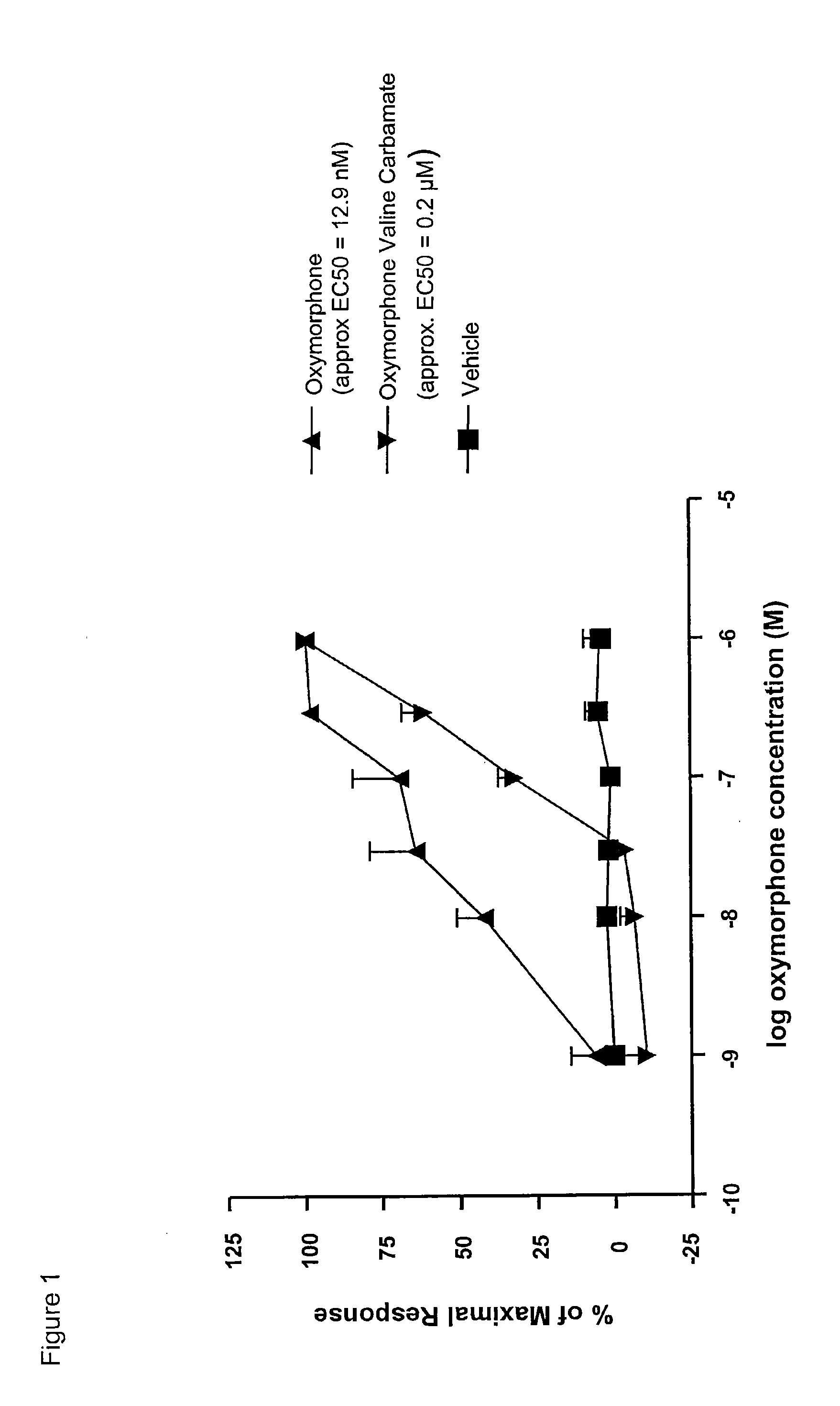Amino acid and peptide prodrugs of opioid analgesics with reduced gi side-effects
a technology of opioid analgesics and amino acids, applied in the field of prodrugs of opioid analgesics, can solve the problems of marked liver toxicity, unfavorable pain appropriate treatment, and not without side effects, so as to reduce the effects of gut transit, avoid and reduce adverse gi side effects
- Summary
- Abstract
- Description
- Claims
- Application Information
AI Technical Summary
Benefits of technology
Problems solved by technology
Method used
Image
Examples
example 1
Generic Route of Synthesis of Amino Acid Carbamate Conjugates of Opioids
[0226]A route to phenolic opioid prodrugs as HCl or TFA salts via amino acid tert-butyl esters (with valine as an example) is given in Scheme 4, below.
[0227]A route to phenolic opioid prodrugs via amino acid benzyl esters is given in Scheme 5, below (using valine as an example).
[0228]The first route (Scheme 4) is suitable for non-acid sensitive phenolic opiods, whereas the second route (Scheme 5) is suitable for those which are acid sensitive but do not contain any reducible functionalities such as double bonds.
example 2
Synthesis of Oxymorphone (S)-Valine Carbamate Hydrochloride
[0229]The synthetic route is shown in scheme 6, below:
[0230]A suspension of (S)-valine tert-butyl ester hydrochloride (2.20 g, 10.5 mmol) and pyridine (3.37 mL, 42.0 mmol, 3.30 g) in anhydrous dichloromethane (60 mL) was cooled in an ice-bath under nitrogen. Next, 20% phosgene in toluene (7.35 mL, 14.0 mmol, 6.90 g) was added dropwise to the stirred mixture. Stirring was continued for a further 2 hours while the reaction was allowed to warm to room temperature. The resulting mixture was diluted with more dichloromethane, and washed with ice-cold 1 M hydrochloric acid, followed by brine and was then dried (MgSO4) and concentrated to give an oil (2.0 g).
[0231]The oil was dissolved in anhydrous toluene (50 mL) and oxymorphone free base (1.97 g, 6.56 mmol) was added to the solution. The solution was then heated at reflux for 4 hours (the oxymorphone was not initially soluble in toluene but dissolved slowly as the reaction procee...
example 3
Synthesis of Hydromorphone (S)-Valine Carbamate Trifluoroacetate
[0236]This synthetic route is outlined in Scheme 7, below:
[0237]A suspension of (S)-valine tert-butyl ester hydrochloride (464 mg, 2.21 mmol) and pyridine (0.72 mL, 8.92 mmol, 0.71 g) in anhydrous dichloromethane (10 mL) was cooled in an ice-bath under nitrogen. Next, diphosgene (173 μL, 1.43 mmol, 283 mg) was added dropwise to the stirred mixture. Stirring was continued for a further 2 hours while the reaction was allowed to warm to room temperature. The resulting mixture was diluted with more dichloromethane and then washed with ice-cold 1 M hydrochloric acid, followed by brine. After which, the mixture was dried (MgSO4) and concentrated to give an oil (0.40 g).
[0238]The oil was dissolved in anhydrous toluene (10 mL), hydromorphone free base (0.42 g, 1.47 mmol) was added and the solution. The solution was then heated at reflux for 4 hours (the hydromorphone was not initially soluble in toluene but dissolved slowly ove...
PUM
| Property | Measurement | Unit |
|---|---|---|
| length | aaaaa | aaaaa |
| disorder | aaaaa | aaaaa |
| intracranial pressure | aaaaa | aaaaa |
Abstract
Description
Claims
Application Information
 Login to View More
Login to View More - R&D
- Intellectual Property
- Life Sciences
- Materials
- Tech Scout
- Unparalleled Data Quality
- Higher Quality Content
- 60% Fewer Hallucinations
Browse by: Latest US Patents, China's latest patents, Technical Efficacy Thesaurus, Application Domain, Technology Topic, Popular Technical Reports.
© 2025 PatSnap. All rights reserved.Legal|Privacy policy|Modern Slavery Act Transparency Statement|Sitemap|About US| Contact US: help@patsnap.com



